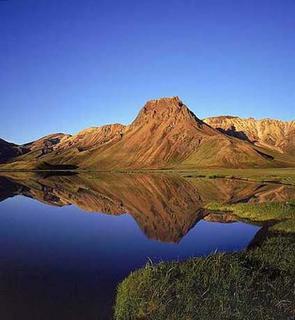
Iceland – Small place, Big Soul
Iceland is a small pace with a big soul. It is designed to startle you all the time. Driving out of Keflavik airport you pass a barren lava field that looks like a lunar landscape. Steam hisses out from geothermal springs underground reminding you that this is a land forged literally out of fire and ice. It is also frightfully expensive and can suck up your devalued dollars out of your wallet like an industrial vacuum cleaner. A 20 minute cab ride from the airport to the center of Reykjavik the capital will set you back $150. Dotted by steaming lava fields, icecaps, glaciers, hot pools, and geysers, the Icelandic landscape has an elemental rawness that makes you aware of the awesome creative power of the earth. Reykjavik, the northernmost capital in the world has a raging nightlife earning it the title of the coolest capital of Europe
Iceland has always held a fascination for me. Tom Clynes had written in the National Geographic about a dramatically lit, ghost-brown place, peppered with lava flows and geysers, populated by farmer-poets and fair beauties. He called it the last great wilderness in Europe with no castles or palaces.
But Icelanders have a strong sense of history and myth woven through the Icelandic sagas. Written by anonymous authors between 1200 and 1400AD, these stories are a mix of real life incidents and glorious exaggerations, that Icelanders use as a key to comprehending their extraordinary environment, their countrymen, and themselves. The sagas are all wild eyed tales of Viking valor and treachery, love and destroyed hopes, soaring heroes and brutal violence. Romantic, fairly tales they are not. Impossible epics of gore, grit, and greatness they are. The Grettis Saga, for example, is the tale of a superhuman outlaw, Grettir the strong, who was on the run for 20 years. Armed with a sword and reciting poetry he roamed the land, plundering travelers, helping widows, and had an occasional tryst with saucy farm girls and the daughters of a giant. In one episode he has an argument with a farmhand named Skeggi which ends when Grettir strikes Skeggi with Skeggi’s own axe through to his brain. He finally holes up on the tallest peak on Dragney island and lives there for several years. The saga ends when local farmers who wanted him to leave storm his hut and with Grettir’s own sword cut off his head
With only 270,000 inhabitants – less than a third of the population of San Francisco living on an island the size of Kentucky - Iceland has emerged as a high-tech welfare state with one of the highest standards of living in the world. Iceland sits remote and mysterious just a few hundred meters south of the Arctic Circle. The sun never sets in the summer and people live in daylight for 24 hours. During winter there is almost no sun and most of the day seems like night. When he is told to get ready for bed, a common question I hear from Vibhu, my host’s five year old is. “Is it night or day?” As far as he can tell, it is bright outside, and he could be out there still playing with Hringur, Byarki, and Ulli.
Reykjavik is small, compact, and very walkable. Modern buildings with interesting architecture live in peace with clapboard house that feature colored tin roofs. Although a small town by world standards and a teeming metropolis compared to other Icelandic towns (Akureyri, the next biggest has 15,000 people) it is packed with restaurants, cafes, museums, theaters, and music venues. The feel is that of an upbeat, fashionable, expensive, youth-oriented small city with a vibrant, art, culture, and music scene.
Reykjavik has an ultra-trendy club scene earning itself titles like the capital of cool and the hippest city on the planet. The nightlife rages mostly around Laugavegur street. On Friday and Saturday nights all the impossibly good looking people in Scandinavia seem to have received the big summons for The Runtur, the great Icelandic pub crawl where party goers go from club to club with names like NASA, Pravda, and Hverfisbarinn progressively getting louder and less inhibited. The Sun is a natural ally. Even at 3AM, Laugavegur street can feel like an Icelandic Times square on New Year’s eve. Why go home yet because the Sun has not set for three months now?
Every Icelander you meet in a bar seems to either perform in a band, writes songs, or is otherwise connected to poetry, writing, or art. Iceland publishes the greatest number of books per capita in the world. And this is the land that gave birth to Bjork, Sugarcubes and Quarashi.
2 comments:
Gopi,
Reading your extensive write-up on Iceland has been a treat. I remember back in middle school that the one place I wanted to visit was Iceland, largely due to an article (like you) in the National Geographic called Iceland - Life Under the Glacier (by Louise E. Levathes, Feb 1987 - I still have the issue). Can you imagine asking a geeky 6th grader where he wanted to go if he had all the money in the world, and then hearing the squeeky reply: "Iceland!" Thanks again for the great treatment of a neglected land. Or, only neglected by those who don't care to know about it.
So beautiful pic...
Regards
custom bowling shirts
Post a Comment